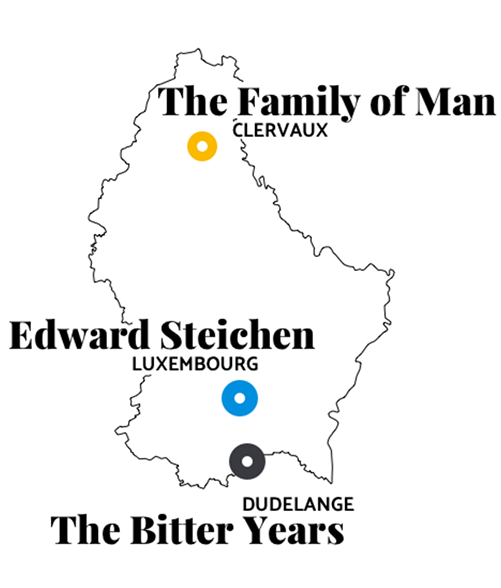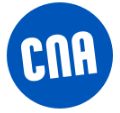Collections
The Steichen Collections of the Grand-Duchy of Luxembourg assemble works that are connected to the heritage of Edward J. Steichen (1879 – 1973). The American artist of Luxembourgish descent is world famous for his remarkably long and fruitful career related to photography. Not only was Edward Steichen a very prolific photographer, he was also director of the photography department at the Museum of Modern Art (MoMA) in New York, where his work as curator of photographicexhibitions was acclaimed worldwide.
The collections on display in Luxembourg reflect his two-fold activity: while the MNHA and the Villa Vauban honour the photographer with a selection of his private and commissioned works, the Centre national de l’audiovisuel (CNA) with its two collections The Family of Man and The Bitter Years, highlights his achievements as curator, assembling the works by famous photographers.
See the brochure
Biography Edward J. STEICHEN
The life of Edward Steichen (1879-1973) spanned a rich and varied artistic career: known above all for his photography work, he was also a painter, director, MoMA curator, gardener and passionate experimenter.

Edward Steichen, Self-Portrait with Camera, c. 1917 © 2015 The Estate of Edward Steichen / Artists Rights Society (ARS), New York
- 1879
- Born Bivange (Luxembourg), March 27. Fils de Jean-Pierre Steichen et de Marie Steichen Kemp.
- 1881
- Steichen family moves to the United States; Edward Steichen naturalized as citizen
- 1894-1898
- Apprentice at lithography company, Milwaukee, Wisconsin
- 1899
- First photographs exhibited at Philadelphia Photographic Salon
- 1900
- First solo exhibition at private home, Milwaukee, WI; studies at Academie Julian, Paris.
- 1901
- Paintings and photographs exhibited in Paris; elected member of Linked Ring: London photographic society; meets Rodin.
- 1902
- Among founders of Photo-Secession group; first solo exhibition at Maison des Artistes, Paris; establishes studio at 291 Fifth Avenue
- 1903
- Marries Clara Smith (divorced 1922; two daughters: Dr. Mary Steichen [Martin] Calderone [1904-1998] and [Charlotte] Kate Rodina Steichen [1908-1988])
- 1905
- Stieglitz opens Little Gallery of the Photo-Secession, later Gallery 291, in Edward Steichen's former studio and first shows "modern" art (Cézanne, Picasso, Maurer, and others)
- 1906
- Returns to Paris
- 1908
- Arranges through Leo and Gertrude Stein for Ecole de Paris artists to be seen in the United States; rents farmhouse at Voulangis, France; sister Lilian marries Carl Sandburg (1878-1967)
- 1910
- First creates delphinium hybrids at Voulangis
- 1911
- First fashion photography, of gowns by Poiret
- 1911-1914
- Creates painted murals (In Exaltation of Flowers) for residence of Agnes and Eugene Meyer
- 1913
- First experimental photographs of plant forms, flowers, and insects
- 1914
- Returns to United States at outbreak of war
- 1917
- Commissioned as Lieutenant in U.S. Army Signal Corps Photographic section; supervises aerial reconnaissance photography in France
- 1919-1922
- Continues experiments in object photography; burns paintings in garden of Voulangis studio
- 1922
- Divorces Clara Smith Steichen
- 1923
- Marries Dana Desboro Glover (d. February 20, 1957)
- 1923-1924
- Occupies photographic studio at 80 W. 40th Street, New York City
- 1923-1938
- Chief Photographer, Condé Nast publications; photographs appear in Vogue and Vanity Fair; begins photographic work for J. Walter Thompson advertising agency
- 1928
- Designs pianos; begins breeding delphiniums at Umpawaug farm, Redding, CT
- 1929
- Carl Sandburg's Steichen the Photographer published
- 1930-1931
- Collaborates with daughter Mary on The First Picture Book: Every Day Things for Babies, and The Second Picture Book
- 1932
- First color cover of Vogue
- 1935-1937
- Occupies photographic studio at 139 E. 69th Street; selects photographs for U.S. Camera Annuals
- 1936
- Exhibits delphiniums at MoMA: Edward Steichen's Delphiniums [exhibition at MoMA, June 24-July 1, 1936]
- 1938
- Retires from Condé Nast, moves to Umpawaug farm, Redding, CT
- 1941
- Joins U.S. Navy as organizer of Naval Aviation Photographic Unit; by 1945, is in command of all naval combat photography
- 1942
- Designs Road to Victory [exhibition at MoMA, May 21-October 4, 1942] in collaboration with Carl Sandburg
- 1943
- Aboard U.S.S. Lexington
- 1944
- Supervises U.S. Navy film The Fighting Lady, winner 1945 Academy Award for Documentary Film
- 1945
- Named director U.S. Navy Photographic Institute, which was established "to promote and encourage photography on Naval subjects" (see folder IV.B.29); creates Power in the Pacific [exhibition at MoMA, January 23-March 20, 1945]
- 1947
- Named Director, Department of Photography MoMA; discontinues photographic career to promote younger photographers
- 1952
- Begins preparations for The Family of Man, assisted by Wayne Miller, including travel in the United States and Europe to obtain photographs for selection
- 1955
- The Family of Man opens at MoMA [exhibition at MoMA, January 24-May 8, 1955]
- 1955-1960
- Begins color exploration, on still and moving image film, of shadblow tree on Umpawaug property
- 1957
- Dana Steichen dies
- 1959
- Travels to Russia with Carl Sandburg for Moscow opening of The Family of Man
- 1960
- Marries Joanna Taub (1933-2010)
- 1961
- Last exhibition at MoMA: Steichen the Photographer [exhibition at MoMA, March 28-May 30, 1961]; establishment of Edward Steichen Photography Center in planned new MoMA building
- 1962
- Retires and named Director Emeritus; John Szarkowski becomes Director of Photography
- 1963
- A Life in Photography published; Edward Steichen awarded Presidential Medal of Freedom by John F. Kennedy, presented by Lyndon Johnson; meets the Grand Duchess Josephine-Charlotte of Luxembourg at the White House
- 1964
- Edward Steichen Photography Center opens at MoMA with exhibition Edward Steichen Photography Center [exhibition at MoMA, May 27, 1964- ] ; The Family of Man exhibition given to Luxembourg
- 1966
- Visits Luxemburg with Joanna Steichen
- 1973
- Dies March 25, two days before 94th birthday














